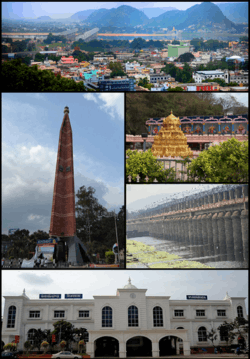Vijayawada
| Vijayawada విజయవాడ Bejjamwada, Bezawada, Rajendracholapuram | |
|---|---|
| Metropolis | |
|
Clockwise from Top Left:Vijayawada City View, Kanakadurga Temple on Indrakeeladri, Prakasam Barrage, Vijayawada Junction Railway Station, VMC Pylon | |
| Nickname(s): The Place of Victory | |
 Vijayawada Location of Vijayawada in Andhra Pradesh | |
| Coordinates: 16°31′09″N 80°37′50″E / 16.5193°N 80.6305°ECoordinates: 16°31′09″N 80°37′50″E / 16.5193°N 80.6305°E | |
| Country | India |
| State | Andhra Pradesh |
| District | Krishna |
| Founded by | Arjuna |
| Named for | Victory |
| Government | |
| • Type | Mayor–Council |
| • Body | Vijayawada Municipal Corporation |
| • MLAs |
List of MLAs
|
| • MP | Kesineni Srinivas |
| • Municipal commissioner | G.Veerapandian |
| • Mayor | Koneru Sridhar |
| Area[1] | |
| • Metropolis | 61.88 km2 (23.89 sq mi) |
| • Metro | 110.44 km2 (42.64 sq mi) |
| Area rank | 6th (in state) |
| Elevation[2] | 23 m (75 ft) |
| Population (2011)[3][4][5] | |
| • Metropolis | 1,034,358 |
| • Rank |
27th (India) 2nd (Andhra Pradesh) |
| • Density | 16,939/km2 (43,870/sq mi) |
| • Metro[3] | 1,491,202 |
| Demonym(s) | Vijayawadian[6] |
| Languages | |
| • Official | Telugu |
| Time zone | IST (UTC+5:30) |
| PIN | 520 XXX |
| Telephone code | +91–866 |
| Vehicle registration | AP–16 (AP 17, AP 18 and AP 19 reserved) |
| Website |
vijayawada |
Vijayawada is a city on the banks of the Krishna River, in the Indian state of Andhra Pradesh. It is a municipal corporation and the headquarters of Vijayawada (urban) mandal in Krishna district of the state. The city forms a part of Andhra Pradesh Capital Region and the headquarters of Andhra Pradesh Capital Region Development Authority is located in the city.[7] The city is one of the major trading and business centres of the state and hence, it is also known as "The Business Capital of Andhra Pradesh".[8][9] The city is one of the two metropolis in the state, with the other being Visakhapatnam.
As of 2011 census, the city had a population of 1,048,240, making it the second largest city in the state in terms of population and it had an urban agglomeration population of 1,491,202.[3] As per the Demographia World Urban Areas:2016, the city is the third most densely populated in terms of urban population in built-up areas of the world.[10] The city has been recognised as a "Global City of the Future" by McKinsey Quarterly.[11] It is one of the commercial hubs of Andhra Pradesh with a GDP of $3 billion in 2010, and is expected to increase to $17 billion by 2025.[12]
Toponomy
There are many legends behind the origin of the name Vijayawada. Goddess Durga killed the demon and relaxed in this place for some time. As she was victorious (vijaya), the place came to be known as Vijayawada (vijaya translates to victory and wada as place/location, literally "The Place of Victory").[13] The epic Mahabharata refers to the Indrakiladri hills as the place where Arjuna secured Pashupatastra from Lord Shiva. The city thereafter came to be known as Vijayavatika and later as Vijayawada.[14] In some legends, Vijayawada was referred to as Rajendracholapura. A tale behind its acquiring the name "Bezawada" is that Goddess Krishnaveni (River Krishna) requested Arjuna to make a passage for her to merge into the Bay of Bengal. Hence, Arjuna made a bejjam (hole) through the mountains and the place came to be known as Bejjamwada which later changed to Bezawada.[15][16]
History
Vijayawada history reveals that Bezawada (Vijayawada) was ruled by King Madhava Varma (Ancestor of Pusapatis of Vizianagaram).[17] Chinese Buddhist scholar Xuanzang stayed few years in Bezawada (Vijayawada) in around 640 A.D. to copy and study the Abhidhamma Pitaka, the last of the three pitakas (Pali for baskets) constituting the Pali canon, the scriptures of Theravada Buddhism.[18]
Geography
Vijayawada is located at 16°31′09″N 80°37′50″E / 16.5193°N 80.6305°E and has an altitude of 11 m (36 ft).[2] It lies on the banks of Krishna River and is also surrounded on the north by Budameru River. The northern, northwestern, and southwestern parts of the city are covered by a low range of hills, while the central, southwestern and northwestern parts are covered by rich and fertile agriculture lands with three major irrigation canals. The topography of Vijayawada is flat, with a few small to medium-sized hills. The Krishna River runs along the city. These hills are part of the Eastern Ghats cut through by the Krishna river. Three canals originating from the north side of the Prakasham barrage reservoir, Eluru, Bandar and Ryves, run through the city.[19]
Climate
Vijayawada has a tropical climate with hot summers and a monsoon season. Temperatures can reach 47 °C (117 °F) in May–June, while the winter temperatures rarely fall below 15 °C (59 °F)
. The average humidity is 78%, and the average annual rainfall is 921.5 millimetres (36 in). Vijayawada gets its rainfall from both the southwest monsoon and northeast monsoon. With its hot and humid conditions, the city is often referred as Blazewada.[20]
| Climate data for Vijayawada (1981–2010) | |||||||||||||
|---|---|---|---|---|---|---|---|---|---|---|---|---|---|
| Month | Jan | Feb | Mar | Apr | May | Jun | Jul | Aug | Sep | Oct | Nov | Dec | Year |
| Average high °C (°F) | 30.2 (86.4) |
32.9 (91.2) |
35.7 (96.3) |
37.9 (100.2) |
40.0 (104) |
37.6 (99.7) |
33.9 (93) |
32.8 (91) |
33.1 (91.6) |
32.1 (89.8) |
31.2 (88.2) |
30.2 (86.4) |
34.0 (93.2) |
| Average low °C (°F) | 18.6 (65.5) |
20.3 (68.5) |
22.7 (72.9) |
25.4 (77.7) |
27.2 (81) |
27.0 (80.6) |
25.4 (77.7) |
25.1 (77.2) |
24.9 (76.8) |
23.7 (74.7) |
21.2 (70.2) |
18.9 (66) |
23.4 (74.1) |
| Average precipitation mm (inches) | 1 (0.04) |
4 (0.16) |
5 (0.2) |
15 (0.59) |
71 (2.8) |
136 (5.35) |
250 (9.84) |
197 (7.76) |
164 (6.46) |
169 (6.65) |
45 (1.77) |
10 (0.39) |
1,067 (42.01) |
| Average precipitation days | 0.5 | 0.5 | 0.9 | 0.8 | 2.5 | 6.8 | 12.1 | 10.5 | 8.8 | 7.7 | 2.5 | 0.8 | 54.5 |
| Source #1: India Meteorological Department[21] | |||||||||||||
| Source #2: Climate-Data.org[22] | |||||||||||||
Demographics
| Historical population | ||
|---|---|---|
| Year | Pop. | ±% |
| 1871 | 8,206 | — |
| 1881 | 9,366 | +14.1% |
| 1891 | 20,224 | +115.9% |
| 1901 | 24,224 | +19.8% |
| 1911 | 32,867 | +35.7% |
| 1921 | 44,159 | +34.4% |
| 1931 | 60,427 | +36.8% |
| 1941 | 86,184 | +42.6% |
| 1951 | 161,198 | +87.0% |
| 1961 | 234,360 | +45.4% |
| 1971 | 344,607 | +47.0% |
| 1981 | 543,008 | +57.6% |
| 1991 | 845,756 | +55.8% |
| 2001 | 1,039,518 | +22.9% |
| 2011 | 1,491,202 | +43.5% |
| Since 1871, the population is that of Vijayawada Urban Agglomeration
Sources: Rao, Kondapalli Ranga; 1. Rao, M. S. A. (1984). Cities and Slums: A study of a Squatters' Settlement in the City of Vijayawada. Concept Publishing Company. p. 12. 2. Provisional Population Totals, Census of India 2011 City Name:VIJAYAWADA | ||
As of 2011 Census of India, the city had a population of 1,048,240. The total population constitute, 524,918 males and 523,322 females —a sex ratio of 997 females per 1000 males, higher than the national average of 940 per 1000.[23] 92,848 children are in the age group of 0–6 years, of which 47,582 are boys and 45,266 are girls—a ratio of 951 per 1000. The average literacy rate stands at 82.59% (male 86.25%; female 78.94%) with 789,038 literates, significantly higher than the national average of 73.00%.[3][24]
The Vijayawada urban agglomeration had a population of 1,491,202.[3] The city's population is expected to reach 2.5 million by 2025.[11]
In 2016, Vijayawada had a projected population of 17.7 lakh living in 57 square kilometres of land area – 31,200 people in every square km. It is this most density populated city in the world in 1022 cities as per UN data.[25]
Governance
Civic administration
Vijayawada Municipal Corporation is the civic governing body of the city. It was constituted on 1 April 1888, and was upgraded to selection grade municipality in 1960 and finally to corporation in the year 1981. The jurisdictional area of the corporation is spread over an area of 61.8 km2 (23.9 sq mi) with 59 wards.[26]
Vijayawada urban agglomeration is spread over an area of 110.44 km2 (42.64 sq mi) in two districts of Krishna and Guntur.[1] Its constituents in Krishna district are Vijayawada municipal corporation, out growths of Gollapudi, Jakkampudi, Ambapuram, Phiryadi Nainavaram, Pathapadu, Nunna, Enikepadu, Nidamanuru, Done Atkuru, Ganguru, Penamaluru, census towns of Ramavarappadu, Prasadampadu, Kanuru, Poranki, Tadigadapa, Yenamalakuduru. While, in Guntur district are Tadepalle municipality and its out growth of Undavalli, Mangalagiri municipality and its out growths of Navuluru and Atmakur.[27]
The present municipal commissioner of the city is G.Veerapandian.[28] While, the present mayor is Koneru Sridhar.[29]
Utility services
Water supply, maintenance of roads, drainage and Solid waste management services are provided by the Vijayawada Municipal Corporation. There exists underground drainage system in the city since 1967–68. Many green parks are maintained by the corporation to protect the environment such as, Raghavaiah park, Rajiv Gandhi park, Dr.B.R Ambedkar park, Mahatma Gandhi park etc.[30] As per National Urban Sanitation Policy, the city was ranked 24th in the country in 2009–10, with a total of 24.580 points.[31] The corporation won many awards and achievements such as, National Urban Water Award (2009), Siti e-Governance Project by CRISIL, CSI Nihilent runner-up, finalists in Stockholm Challenge, ISO 9001 certification for Quality Management System.[1]
Law and Order
The Vijayawada City Police is headed by a Police Commissioner, who is an Indian Police Service officer of Additional Director General of Police rank along with two Deputy Commissioners of Police who are also IPS officers. The present Police commissioner is Goutham Savangh.[32] This city also has its own Commissionarate.
Economy
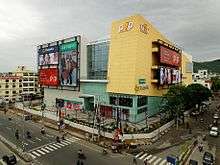
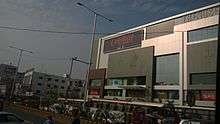
Agriculture, commercial trade, tourism, industries, transportation and tertiary sectors etc., are the major sectors that contribute to the economy of the city. Vijayawada is famous for processing of agricultural products, automobile body building, hardware, textile, consumer goods and small scale industries. GDP of Vijayawada for 2008 was stimated at Rs 55.26 billion and it was $3 billion (Rs. 180 billion) in 2010.[11][33] The fact that Vijayawada is well connected through rail and road, makes it one of the main hubs of commercial activities.
The city is promoting the usage of renewable energy sources. It is one of the city in the state to use biodiesel, alongside Visakhapatnam.[34] The city is covered under Solar/Green Cities scheme launched by the Ministry of New and Renewable Energy and is one of the 15 cities in the country listed in Pilot Solar Cities.[35]
Agro-based industries such as cotton, turmeric, and Virginia tobacco are located in the surrounding areas. There are also oil, dal and rice mills located at Kondapalli. Real Estate is another sector in Vijayawada which is very high in property prices and are comparable with top cities of India.
Industrial estates
The two well equipped industrial estates in Vijayawada are Auto-Nagar and other near Kondapalli. The Jawahar Lal Nehru Auto Nagar Industrial Estate in Vijayawada is one of the largest auto industry hubs of Asia. The industrial estate in Kondapalli suburb is spread over 450 acres (1.8 km2), and is base to more than 800 industries. The Kondapalli Estate houses thermal power plants, and is base to more than 800 industrial units. Kondapalli suburb also houses Andhra Pradesh Heavy Machinery and Engineering Limited (APHMEL) factory.[36] It is also a hub for storage, bottling and transportation of petroleum products of all major companies like BPCL, HPCL, IOC etc.[37]
Culture
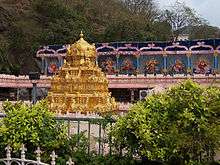
The city has good history in art, literature and culture. There exists many religions, languages with different traditions and festivals.[38] Dussera celebrations are noticeable which involves Durga Pooja, Theppotsavam[39] mainly due to the existence of self manifested Kanaka Durga Temple, other festivals like Ganesh Chaturthi, Diwali etc., of Hindus, Eid ul-Fitr of Muslims and Christmas of Christians. The clothing includes traditional men wearing dhoti and women wearing saree and salwar kameez. Western clothing is also predominant in the urban areas.[40]
Arts, crafts and artefacts
Vijayawada Art Society promotes Telugu arts.[41] The city had hosted Poetic Prism-2015, a multi-lingual poet's meet in the city on 19 September 2015. All these activities are organised in collaboration with organisations like the Cultural Centre of Vijayawada.[42] Kondapalli Toys are an example handmade toys by local artisans at Kondapalli village, a suburb of Vijayawada.[43] Victoria Jubilee Museum is an archaeological museum which has sculptures, paintings and artefacts of Buddhist and Hindu relics, dated back to 2nd and 3rd centuries.[44]
Cityscape
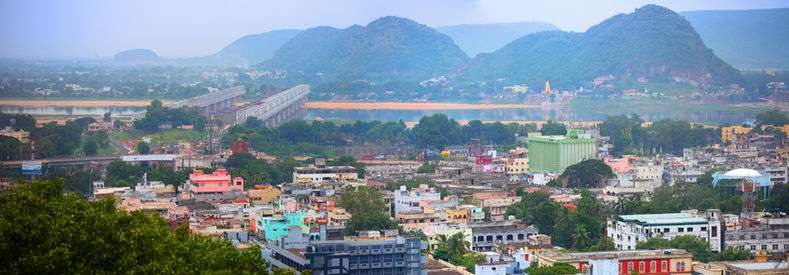

The city of Vijayawada has old and new town areas. The I–Town area of the city is known as Old city area, comprising areas such as, Islampet, Jendachettu Centre, Kamsalipet, Rajarajeswaripet, Kothapet, Ajithsinghnagar, Jendachettu Centre and Winchipet.[45] The new city areas includes areas such as, Autonagar, Benz circle, Chuttugunta, Labbipet, Machavaram Down, Mogalrajapuram, NTR circle, Tikkle Road, Governorpet, Pinnamaneni Polyclinic Road and Suryaraopet.[45][46][47]
Brindavan Colony, Commercial Taxes Colony, Gunadala, Veterinary Colony are some of the residential areas in the city.[46] While, Bank Colony, Bharati Nagar, Currency Nagar, Satyanarayana Puram, Gurunanak Colony, LIC Colony, Patamata and MG Road are the upscale residential areas.[48][49] The major commercial areas in the city include the stretch of MG Road and from Benz Circle to Ramavarappadu Ring.[46][49] Other commercial centres are Besant Road, Rajagopalachari street, One town market area covering Kaleswara Rao Market and Vastralatha.[50][51][52]
The city has many landmarks which include, Prakasham Barrage across the Krishna river;[53] Krishnaveni Mandapam (River Museum) depicting the history of Krishna river and a nearby idol of the river known as, Krishnaveni statue; Gandhi Hill, the first Gandhi Memorial in the country, located at an elevation of 500 ft on the on a hill; Bhavani Island, one of the largest river island amidst Krishna River. There are also landmarks of religious importance such as, Kanaka Durga Temple on Indrakeeladri hill;[14] Hazarat Bal Mosque, a holy relic of the Prophet Mohammed; and the Gunadala Mary Matha Church installed by St. Joseph's Orphanage.
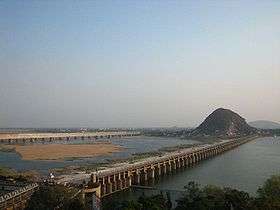
Nearby landmarks in the surrounding suburbs include Mogalarajapuram Caves (5th century AD), Undavalli Caves (7th century AD Buddhist landmark), Kondapalli Fort (7th century AD) in Kondapalli village etc., Lord Narasimha temple in Mangalagiri, located 14 km from the city, is the abode of Lord Narasimha. Kondapalli Forest, located 20 km from Vijayawada, is spread over 121.5 square kilometres (30,000 acres). The fauna include of this forest include leopards, wild dogs, jackals, wild boar, wolves etc.[54]
Transport
The city is known for traffic Jams both on Roads and in Railways.[55]
Road
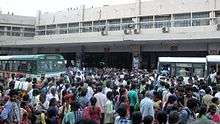
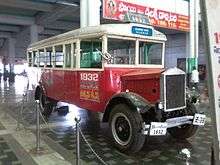

Vijayawada is well connected to the major destinations through various national and state highways. National Highway 16, a part of Asian Highway 45 and Golden Quadrilateral is a major highway that passes through the city and connects Kolkata and Chennai.[56] While, other highways such as, National Highway 65 links the city with Pune–Machilipatnam route and National Highway 221 with Jagdalpur of Chhattisgarh. Inner Ring Road connects both NH 16 and 65 and serves the main purpose of easing city traffic congestion.[57] Canal Road, M.G.Road and Eluru Road are the major internal arterial roads of the city.[58][59] It is connected to other areas of the district by district roads and the city has a total road length of 1,264.24 km (785.56 mi).[60]


The Pandit Nehru Bus Station was inaugurated on 23 September 1990 and was officially named as Telugu Satavahana Prayana Pranganam later renamed to its current name. It is Fourth largest and busiest bus terminals in India alongside Delhi, CMBT (Chennai) and MGBS (Hyderabad). State run APSRTC buses are operated from the terminal. APSRTC runs more than 450 city buses in the city which include Ordinary, Metro Express and City Sheetal (A/C Buses). It is the first city in the south India to introduce CNG buses in its fleet. Vijayawada Municipal Corporation (VMC) has a BRTS circuit of 15.5 km in the city.[61][62]
Private bus operators also provide transport services. Motor-driven auto-rickshaws and manual-driven cycle-rickshaws are the other alternative means of transport within Vijayawada. Private lorries, cars and two-wheelers are common.
Rail

Vijayawada railway station is an important junction in South Central Railway zone of Indian Railways. It is situated along the Howrah-Chennai main line and Delhi–Chennai line and categorised as an A-1 station under the jurisdiction of Vijayawada railway division.[63] It is one of the busiest station, handling more than 320 trains (both passenger and freight trains) per day next to Howrah and Mumbai. It has an Electric Loco Shed with a capacity to maintain 100 Electric Locomotives and a Wagon workshop at Guntupalli, near Vijayawada. Madhuranagar, Gunadala, Rayanapadu, Kondapalli, Nidamanuru, Krishna Canal, Ramavarappadu, Kolanukonda, Mangalagiri, Gannavaram are the other railway stations in the city.
Air
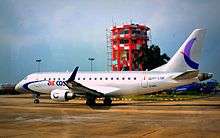
Vijayawada Airport is located at Gannavaram. It connects the city Hyderabad, Bangalore, Coimbatore, Chennai, Delhi, Visakhapatnam, Tirupati and Kadapa. Vijayawada Airport is served by Air India, SpiceJet, TruJet and Air Costa. Annually, about 380,000 passengers use this airport. A plan for its expansion has been proposed which will enable the landing of larger aircraft and also provide night landing facilities.
Education
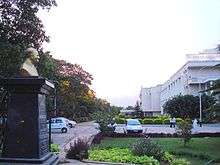
The primary and secondary school education is imparted by government, aided and private schools, under the School Education Department of the state.[64][65] As per the school information report for the academic year 2015–16, the city limits have more than one lakh students enrolled in approximately 500 schools.[66][67] The state and CBSE syllabus are followed by schools for the Secondary School Certificate.[68][69] The medium of instruction followed by schools are English, Telugu and Urdu.[70]
Andhra Pradesh Library Association has its headquarters located at Vijayawada.[71]
Colleges & Universities
The first college built in Vijayawada was SRR & CVR Government College. Andhra Loyola College was established in 1953. The Govt Polytechnic College was established here in 1960. The first private engineering college in Andhra Pradesh, V R Siddhartha Engineering College, is located here. School of Planning and Architecture, Vijayawada (SPAV) was established in 2008, a higher education institute in Vijayawada. It is one of the three School of Planning and Architecture (SPAs) established by the Ministry of Human Resource Development in 2008 as an autonomous institute and a fully Central funded Institution.
There are many other colleges namely MIC College of Technology, Prasad V. Potluri Siddhartha Institute of Technology, Nalanda Degree College, Maris Stella College, P.B. Siddhartha College of Arts and Sciences, Andhra Loyola Institute of Engineering & Technology, Potti Sriramulu College of Engineering & Technology.
Media
The major Telugu newspapers in city are Eenadu, Sakshi, Andhra Bhoomi, Andhra Prabha, Vaartha, Suryaa, Prajasakti and Vishalandra. The major English newspapers in the city are The Hindu, The Times of India, Deccan Chronicle, The Hindu Business Line, The New Indian Express and The Hans India. Electronic Media include HMTV, ETV and Sakshi.
Sports
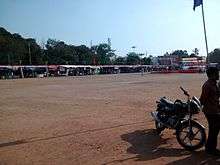

Cricket is the most popular sport, with national-level matches played at Indira Gandhi Stadium.[72] It is also the stadium for Krishna District Cricket Association. Mangalagiri International Cricket Stadium is being built in a 20-acre (8.1 ha) site in Navuluru, village of Mangalagiri town, Guntur district, about 15 km from the city of Vijayawada. The exclusive stadium of the Andhra Cricket Association will be the venue for international and Ranji matches.[73] Only one international cricket match was played between India and West Indies on 24 November 2002 at Indira Gandhi stadium. It was won by West Indies. The biggest cricket bat record in Guinness Book of World Records currently held by the 100-feet cricket bat installed at this Stadium was kept on display during this match. On 12 December 1997 Women's Cricket Worldcup only a group match was played between England Women's Cricket Team and Pakistan women's cricket team, and it was won by England. Indian women's cricket academy is located in Guntur the twin city of vijayawada. Vijaya Madhavi Tennis Academy is situated in Layola College, led by Shri. Radha Krishna Murthy, a prominent tennis player.
Badminton, volleyball and chess are also popular.
See also
- Economy of Vijayawada
- List of most populous cities in India
- List of million-plus urban agglomerations in India
- List of cities in Andhra Pradesh by population
- List of twin towns and sister cities in India
References
- 1 2 3 "Vijayawada: A Profile" (PDF). Vijayawada Municipal Corporation. p. 1. Retrieved 11 December 2015.
- 1 2 "Maps, Weather, and Airports for Vijayawada, India". fallingrain.com.
- 1 2 3 4 5 "Andhra Pradesh (India): Districts, Cities, Towns and Outgrowth Wards - Population Statistics in Maps and Charts".
- ↑ "Census 2011". The Registrar General & Census Commissioner, India. Retrieved 2 July 2016.
- ↑ "Census 2011". The Registrar General & Census Commissioner, India. Retrieved 2 July 2016.
- ↑ "Amidst land rush, malls vacant". Deccan Chronicle. 9 September 2014. Retrieved 22 September 2014.
- ↑ Special Correspondent. "AP Capital Region Development Authority comes into being". The Hindu.
- ↑ "About Vijayawada". vgtmuda. Archived from the original on 2015-07-22. Retrieved 21 June 2014.
- ↑ "Former name of city". thefreedictionary. Retrieved 20 June 2014.
- ↑ "Vijayawada is third densely packed city; 31,200 people in every square km". Retrieved 2016-08-25.
- 1 2 3 "Global cities of the future: An interactive map | McKinsey & Company". Mckinseyquarterly.com. 13 March 2013. Retrieved 8 August 2013.
- ↑ "Economy of the City" (PDF). City Development Initiative For Asia. Retrieved 31 July 2014.
- ↑ Ross. Corporate Finance 8E. Tata McGraw-Hill Education. p. 272. ISBN 978-0-07-009124-5. Retrieved 30 March 2016.
- 1 2 "Vijayawada Region". AP Tourism. Government of Andhra Pradesh. Retrieved 13 July 2015.
- ↑ Ayyar, P. V. Jagadisa (1993). South Indian Shrines (Rev. and enl. ed.). New Delhi [u.a.]: Asian Educational Services. ISBN 81-206-0151-3. Retrieved 4 August 2014.
- ↑ Reddy, V.V. Subba (2009). Temples of South India. New Delhi: Gyan Pub. House. p. 80. ISBN 978-81-212-1022-5. Retrieved 7 June 2015.
- ↑ Sculptures in a cavern at Bezawara [Vijayawada] supposed to belong to the Jain Religion. 21 August 1815, retrieved 2 September 2013
- ↑ "Xuan Zang stayed in Vijayawada to study Buddhist scriptures".
- ↑ "Andhra Pradesh / Vijayawada News : Canal bunds hot beds for growth of slums spotlight". The Hindu. 23 August 2007. Retrieved 8 August 2013.
- ↑ "Vijayawada weather". Deccan Chronicle. 4 June 2014. Retrieved 25 June 2014.
- ↑ "Vijayawada Climatological Table Period: 1981–2010". India Meteorological Department. Retrieved 27 May 2015.
- ↑ "Climate: vijayawada". Retrieved 19 February 2016.
- ↑ "Sex Ratio". The Registrar General & Census Commissioner, India. Retrieved 2 September 2014.
- ↑ "Chapter–3 (Literates and Literacy rate)" (PDF). Registrar General and Census Commissioner of India. Retrieved 2 September 2014.
- ↑ "Vijayawada is third densely packed city; 31,200 people in every square km".
- ↑ "Vijayawada Municipal Corporation". Ourvmc.org. Retrieved 30 January 2012.
- ↑ "Name of Urban Agglomeration and its State constituent Units-2011" (PDF). Census of India. p. 11,22–23. Retrieved 21 September 2015.
- ↑ "Commissioner's Profile". Vijayawada Municipal Corporation. Retrieved 14 February 2016.
- ↑ "Workshop on fertilizers today". The Hindu. Vijayawada. 8 February 2016. Retrieved 14 February 2016.
- ↑ "Parks in Vijayawada". ourvmc. Retrieved 27 June 2014.
- ↑ "Rank of Cities on Sanitation 2009–2010: National Urban Sanitation Policy" (PDF). Press Information Bureau. National Informatics Centre. Retrieved 22 September 2014.
- ↑ "Police commissioner". andhrajyothy.com.
- ↑ "The rapidly growing, stable markets of southern India – Economy and Politics". livemint.com. 7 September 2009. Retrieved 30 January 2012.
- ↑ Sandeep Kumar, S (11 August 2015). "Biodiesel launched in Vijayawada, Vizag". The Hindu. Vijayawada/Visakhapatnam. Retrieved 21 September 2015.
- ↑ "Mahabubnagar, Vijayawada to be developed as 'Solar Cities'". The Hindu. Hyderabad. 24 August 2015. Retrieved 21 September 2015.
- ↑ "APHMEL". Andhra Pradesh Heavy Machinery & Engineering Limited. Retrieved 25 June 2014.
- ↑ "Industrial Scenario" (PDF). apind.gov.in. p. 10. Retrieved 25 June 2015.
- ↑ "Vijayawada to host Poetic Prism-2015". The Hindu. Vijayawada. 19 September 2015. Retrieved 21 September 2015.
- ↑ "Dussehra festivities end, but joy continues at Vijayawada KanakaDurga temple". Deccan Chronicle. Vijayawada. 5 October 2014. Retrieved 21 September 2015.
- ↑ "Efforts should be made to preserve traditional wear". The Hindu. 23 March 2009. Retrieved 21 September 2015.
- ↑ "Seminar on Telugu art". The Hindu. 14 September 2015. Retrieved 21 September 2015.
- ↑ "Vijayawada to get a Cultural centre". Deccan Chronicle. Hyderabad. 21 January 2015. Retrieved 21 September 2015.
- ↑ Guhan, V (21 June 2003). "Creative Kondapally". The Hindu. Retrieved 21 September 2015.
- ↑ "Museum features". discoveredindia.com. Retrieved 12 June 2014.
- 1 2 Deepthi Nandan Reddy, J (9 June 2014). "Residents of One Town in Vijayawada Worst-hit". The New Indian Express. Vijayawada. Retrieved 28 February 2016.
- 1 2 3 "A road which has an ever-changing story". The Hindu. Vijayawada. 24 December 2015. Retrieved 28 February 2016.
- ↑ "Move over Andhra 'bhojanam', Vijayawada takes to Hyderabadi biryani". Times of India. Vijayawada. 9 February 2016. Retrieved 28 February 2016.
- ↑ Sowmya Sruthi, Ch (19 February 2016). "Tenants feel the pinch of rising rents". The Hans India. Vijayawada. Retrieved 28 February 2016.
- 1 2 "Vijayawada MG Road to get facelift". Deccan Chronicle. Vijayawada. 21 November 2015. Retrieved 28 February 2016.
- ↑ "Jewellers down shutters against PAN card rule". The Hindu. Vijayawada. 11 February 2016. Retrieved 27 February 2016.
- ↑ Sowmya Sruthi, Ch (28 January 2016). "Capital status draws global brands to Vijayawada". The Hans India. Vijayawada. Retrieved 28 February 2016.
- ↑ Sowmya Sruthi, Ch (15 January 2016). "Metro foundation likely in February". The Hans India. Vijayawada. Retrieved 28 February 2016.
- ↑ "PRAKASAM BARRAGE". irrigation.cgg.gov.in. Retrieved 7 May 2016.
- ↑ "Andhra Pradesh / Vijayawada News: Presence of leopards, wild dogs detected in Krishna forests". The Hindu. 25 May 2006. Retrieved 30 January 2012.
- ↑ "Utter confusion on Vijayawada roads as 30 agencies carry out road works".
- ↑ "NHAI Under Pressure to Lay Another Bypass Road". The New Indian Express. 25 August 2014. Retrieved 4 June 2016.
- ↑ "IRR flyover to be completed by Jan. end". The Hindu. 11 December 2015. Retrieved 22 June 2016.
- ↑ "Traffic and Transportation" (PDF). Vijayawada Municipal Corporation. p. 45. Retrieved 22 June 2016.
- ↑ "VMC cautions traders". The Hindu. 16 May 2016. Retrieved 22 June 2016.
- ↑ "Details of Roads in each ULB of Andhra Pradesh". Municipal Administration and Urban Development Department. Retrieved 27 June 2016.
- ↑ "APS RTC want to hold back in the share of VJA BRTS".
- ↑ "JNNURM services in Vijayawada" (PDF). Vijayawada Municipal Corporation. Retrieved 2 June 2014.
- ↑ "Divisional info" (PDF). Indian Railways. Retrieved 15 June 2014.
- ↑ "School Education Department" (PDF). School Education Department, Government of Andhra Pradesh. Retrieved 7 November 2016.
- ↑ "The Department of School Education – Official AP State Government Portal | AP State Portal". www.ap.gov.in. Retrieved 7 November 2016.
- ↑ "Student Information Report". Commissionerate of School Education. Child info 2015–16, District School Education – Andhra Pradesh. Retrieved 8 November 2016.
- ↑ "School Information Report". Commissionerate of School Education. Government of Andhra Pradesh. Retrieved 8 November 2016.
- ↑ Reporter, Staff (29 May 2016). "City students excel in CBSE exam". The Hindu. Retrieved 8 November 2016.
- ↑ "International touch for Vijayawada schools - Times of India". The Times of India. Retrieved 8 November 2016.
- ↑ "VMC schools achieve 89% results in SSC exams". The Hans India. Retrieved 8 November 2016.
- ↑ "About APLA". Andhra Pradesh Library Association. Retrieved 22 March 2015.
- ↑ "Vijayawada cricket stadium". Content-ind.cricinfo.com. Retrieved 30 January 2012.
- ↑ "Andhra Pradesh / Vijayawada News: Keeping home turf in top shape". The Hindu. 4 February 2007. Retrieved 30 January 2012.
External links
| Wikimedia Commons has media related to Vijayawada. |
- Vijayawada Municipal Corporation website
- Vijayawada Kanakadurgamma temple official website
-
 Vijayawada travel guide from Wikivoyage
Vijayawada travel guide from Wikivoyage
